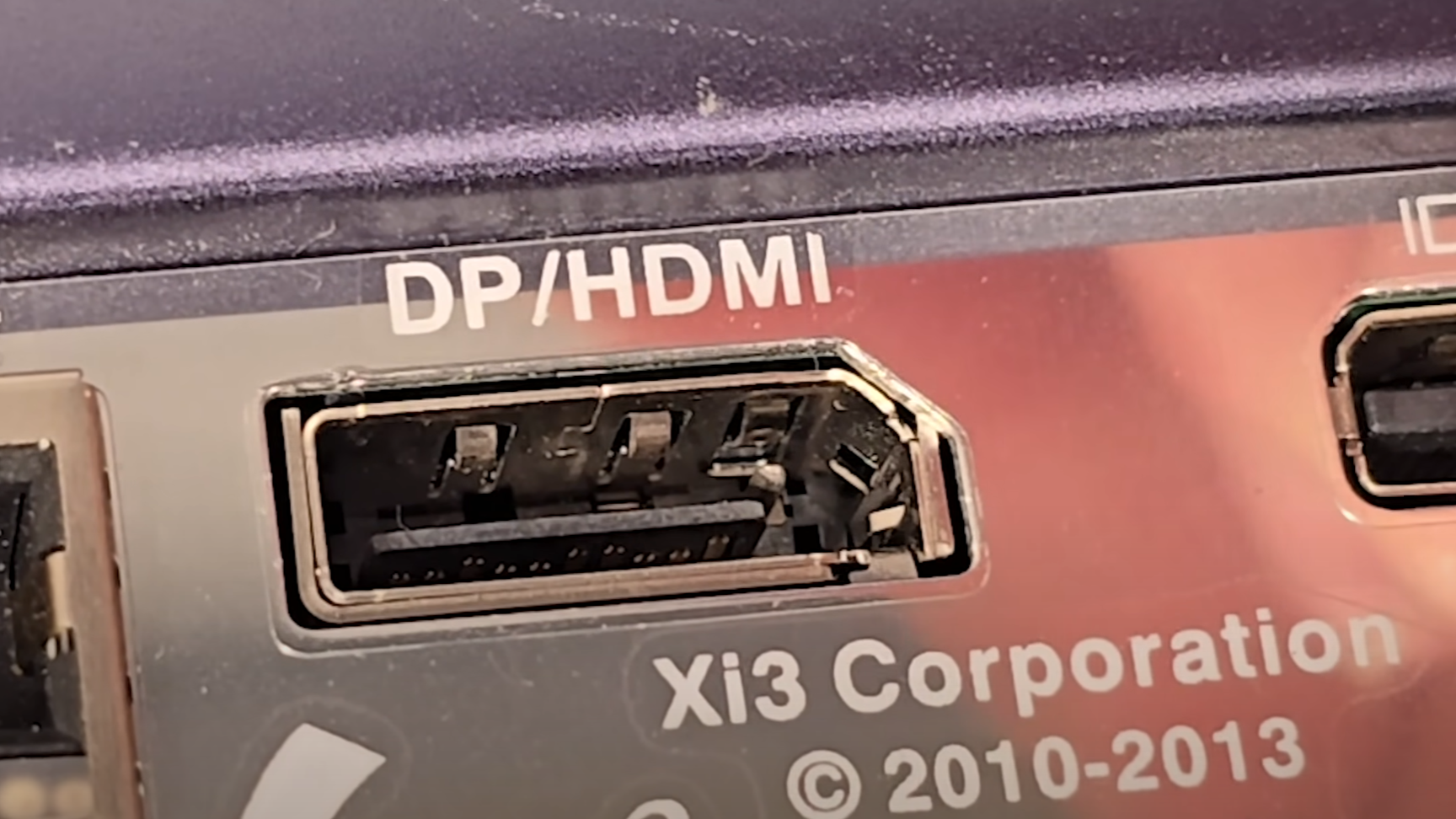Rare port that combines DisplayPort and HDMI discovered on Piston Xi3, the failed Steam Machine
After all these years, a unique combined video port has drawn enthusiast attention.

Earlier this week, we covered the decade-old Xi3 Piston Mini PC being tested by a YouTuber, Bringus Studios. Today, we'll also highlight one of the Piston's most unique, slept-on features: a DisplayPort that can also take HDMI. This information is also sourced from Bringus Studios, though the close-up on the video ports is from a short side-channel video, not the main channel. We've embedded this video below.
In addition to Bringus Studios' coverage, we'll also refer to the PC Watch writeup on the unique DP/HDMI hybrid port, which discusses in a little more detail how this is executed. For now, let's review the original source material, which highlights the true video output versatility of the Xi3 Piston.
So, following Bringus Studios' main Xi3 Piston coverage, a former Xi3 employee reached out on their Discord to clarify the purpose of the combo DP and HDMI port since everyone was under the impression it was a DP port with support for an HDMI signal, not full pin-compatibility.
While Bringus tests the device's video output switching capabilities by changing a BIOS setting and picking HDMI or DisplayPort, he's convinced that the default BIOS option will auto-detect which one happens to be plugged in.
So, what's the takeaway? Obviously, this remarkable, innovative feature doesn't suddenly redeem the name of the Xi3 Piston, which failed for several reasons. While known as one of the first potential "Steam Machines" (or "Steam Boxes") due to getting comfy with Valve, that partnership did not last long following Xi3's decision to support Windows instead of Steam OS.
However, the Xi3 Piston's failure has nothing to do with its genuinely unique video port. The PC Watch analysis looks closer at the connector Bringus believed was used for this—REGO Electronics' HDMI/DisplayPort 2-in-1 Connectors. It utilizes a 21st pin, which is not the original display standard. When "open," HDMI is inserted and operates as HDMI, while DisplayPort actually "closes" that 21st pin, enabling DP operation.
As noted by Bringus, this doesn't feel nearly as tacky as it should. There is no real downside: HDMI and DP output work fine off this specific port and fit snugly as if they're both intended for it. Regular HDMI and DP ports are quite blatantly incompatible with each other's standards, particularly with DP's bracket-shape " [ " internal connector versus HDMI's " | ".
Get Tom's Hardware's best news and in-depth reviews, straight to your inbox.
But by adding an extra pin and cutting the down-hanging pieces of the original DP connector, you can engineer a DisplayPort that takes HDMI input just as well. Considering the modern status quo of GPUs with 3:1 DP: HDMI and monitors that (for some reason) are often the opposite configuration, more motherboards and GPUs could benefit from adopting this combined connector.

Christopher Harper has been a successful freelance tech writer specializing in PC hardware and gaming since 2015, and ghostwrote for various B2B clients in High School before that. Outside of work, Christopher is best known to friends and rivals as an active competitive player in various eSports (particularly fighting games and arena shooters) and a purveyor of music ranging from Jimi Hendrix to Killer Mike to the Sonic Adventure 2 soundtrack.
-
Alvar "Miles" Udell I think it should have long since been a standardized port for use on laptops, although HDMI has since gained many of DisplayPort's advantages over the years.Reply -
setx HDMI forum likely would never license such abomination (by their stance). They have zero benefit from that.Reply -
bit_user ReplyHDMI and DP output work fine off this specific port and fit snugly as if they're both intended for it.
It seems to me that the real unicorn is the connector, itself.
As for the video signal, DisplayPort Dual-Mode (DP++) specifies a port that can switch signalling between DisplayPort and HDMI. It seems most cheap DP -> HDMI adapters are nothing but wires, with no active components. However, they would only work on such Dual-Mode ports, which Wikipedia says is actually the norm (even for ports without the logo).
https://en.wikipedia.org/wiki/DisplayPort#DisplayPort_Dual-Mode_(DP++)
Considering the modern status quo of GPUs with 3:1 DP: HDMI and monitors that (for some reason) are often the opposite configuration, more motherboards and GPUs could benefit from adopting this combined connector.
I don't deal with a lot of gaming boards, but on the mini-PCs and commodity boards I've seen, HDMI seems more prevalent.
It does bug me that gaming monitors seem more biased towards HDMI, especially since VRR support on HDMI was lacking for so long. However, I guess the mix of ports is probably with an eye towards gamers maybe wanting to plug in their consoles, which are HDMI-only. -
cryoburner ReplyPiston Xi3, the failed Steam Machine
This article says it like there were Steam Machines that did not fail. Valve's entire Steam Machine platform was a failure that never took off. Most models of Steam Machines were dumped by their manufacturers within their first year on the market since hardly anyone wanted them. And that's if the manufacturers decided to even go through with plans to release them at all. Valve's official launch of Steam Machines and the Steam Controller was pushed back until 2 years after the Xi3 Piston came out, so it's no wonder that company chose to release the hardware running Windows instead. And even after the official launch, SteamOS was still arguably not ready for prime time, and many games did not run on it. -
bit_user Reply
This made me think back to how they sat in the market, back then. At the time, I think mini PCs weren't really a common thing. Sure, NUCs had already come out, by then, but I think they didn't really start to get very good before Broadwell.cryoburner said:This article says it like there were Steam Machines that did not fail. Valve's entire Steam Machine platform was a failure that never took off. Most models of Steam Machines were dumped by their manufacturers within their first year on the market since hardly anyone wanted them.
Now, as we see machines like Macs that can pack some potent horsepower into such a package, and as Lunar Lake looks set to boost Intel's iGPU performance by several times, I wonder if this might be the decade when mini-PCs gain a degree of respectability as a gaming platform.
IMO, mini-PCs do a reasonable job of splitting the difference between consoles and full-blown desktops. One of the main disadvantages vs. consoles is just that they don't give game developers a standard hardware target to optimize for. Performance-wise, I could imagine a top-spec Lunar Lake NUC possibly getting into the realm of PS5 performance. I think some Mac Mini's are already there (although those versions definitely cost much more than a PS5).
